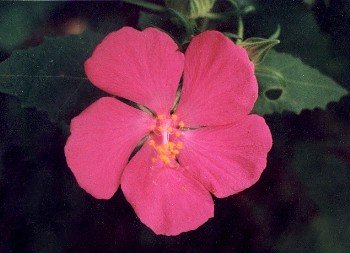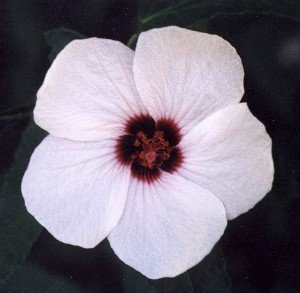Pavonias
by Valerie (May 8, 2002)
This is another case of two very closely related plants being quite different in some respects. Both are in the genus Pavonia and have a similar form to the flowers and seed pods. They are related to mallows and hibiscus, hence the five petals and the projecting stamen and anthers in the middle. Both are also perennial shrubs and are cold hardy enough for our climate, while doing very well in dry conditions. They blossom through much of the summer, even in the shade.

Rock rose (Pavonia lasiopetala) is a native wildflower that grows about two feet tall. Other names for this brilliant pink flower are rock rosemallow, rose mallow and pavonia. The leaves are much like wax mallow, being broad with small notches. The seeds are not difficult to germinate but the percentage seems to be low so that the plant doesn't spread quickly. When I've actually pushed the seeds into the soil, I've been able to establish plants but they don't come up often on their own.
The other pavonia, spearleaf swampmallow (Pavonia hastata) is not nearly so well-behaved. It is native to South America, giving it another common name of Brazilian rock rose. It has either naturalized, or is spreading from its original range, in Australia, where it can get out of control and many sources refer to it as a problem weed in that country. Here in Austin, it does well with the heat, is never affected by drought and produces offspring at an alarming rate. The plant itself is about three feet tall and send out equally long side branches which are thin and droopy. With much pruning, it can look like a normal shrub, but every year it just spreads out more as each branch tends to go at right angles to the previous one, until it is one big tangle. The foliage is a dark bluish green and the leaves are notched slightly but are long and narrow.
In the early part of the summer, the plants have huge numbers of buds, but they just contain seeds and do not bloom. This is called cleistogamy and I would assume the advantage is to make plenty of seeds with the least amount of energy. It's as if the plant is practicing making seeds before it gets down the superfluous activity of blooming. However the seeds are produced, they germinate readily and it is a constant chore to remove the seedlings before they become deep rooted and established. By the later part of summer, blossoms do form and they are large, light pink with maroon centers, and abundant, even in deep shade. Although there are drawbacks, this is an ideal plant for wild areas that get no extra water but could use a bit of color. |
